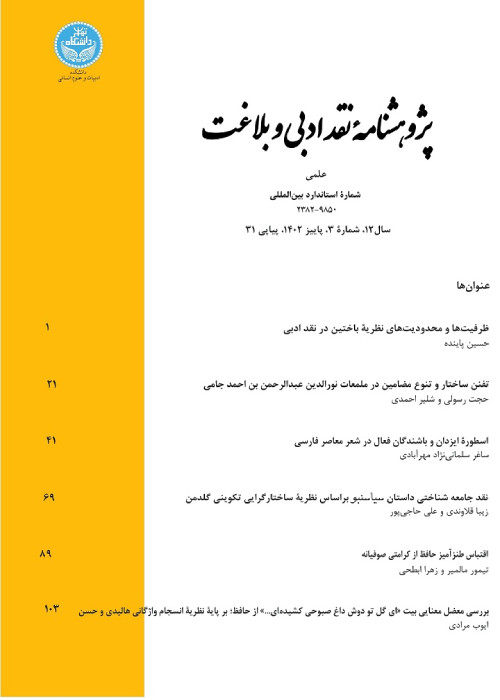Comparing the Structure of Persian Prosody and Iranian Classical Music
Author(s):
Article Type:
Research/Original Article (دارای رتبه معتبر)
Abstract:
From ancient times, there have been references in texts to commonalities between music and prosody. If some musicians consider the origin of Iranian classical music to be prosody and encourage their students to learn the two- and three-syllable metric changes, their purpose is to organize rhythmic circles and find new rhythms, and they did not mean that the structure of music was created in imitation of the prosody. They made prosody the basis of comparison with music in order to have a better understanding of the structure of music through simulation. The temporal primacy of music over prosody and the unification of the structure of music in the ancient world to the contemporary age require that prosody is arisen from music. However; in some cases, the impact of prosody on music.On the one hand, the dimension of skill to music makes its passionates unable to obtain a proper understanding of it even by studying the structure of the music.This article aims to compare the structure of prosody and music, (by mentioning the similarities), provide a special picture of the correct understanding of the structure of music for those who do not know about it, especially the prosodies, and to describe the undeniable role of music in prosody.In addition, the influence of prosody on the structure of the music and its role in the organization of Iranian classical music are determined. The data of this study was collected by library method (and in few cases, field) and the research was conducted with theoretical and library methods , describing and comparing the data.ConclusionsThe equality of musical notes and prosodic syllables in terms of consonants and vowels. Asbab, Otad and Faselh have dual usages. Expressing the characteristics of the tetrachord and reaching the conclusion that among the ten main prosodic pillars , only three pillars are corresponded to the music tetracords. The apperance of tetracords with 5 beats and pentacords with 6 beats in music, by mimicing some prosodic pillars such as Motafaelon and Mafaelaton. Both classical music and the prosodic meters are the result of the combination of tetrachords and prosodic pillars. Meters derived from main prosodic meters are like tonalities creating from one main Maqam. Modulation does not occur in the manner of music in poetry. But perhaps changing the content in poetry can be considered as a kind of modulation.The Proof of Maqami music has been able to be modulated at two levels (internal-mode circulation) and (external-mode circulation) since farabi's time. Musical circles are based on the imitation of prosodic circles. In the prosodic circles,there are two meters, standard and non-standard, with the exact formation of music modes.
Keywords:
Prosody , Music , Tetrachord , Divide Syllables , Tone , Syllable , prosodic circles , Musical Circles
Language:
Persian
Published:
Journal of Literary Criticism and Rhetoric, Volume:12 Issue: 1, 2023
Pages:
59 to 80
magiran.com/p2638431
دانلود و مطالعه متن این مقاله با یکی از روشهای زیر امکان پذیر است:
اشتراک شخصی
با عضویت و پرداخت آنلاین حق اشتراک یکساله به مبلغ 1,390,000ريال میتوانید 70 عنوان مطلب دانلود کنید!
اشتراک سازمانی
به کتابخانه دانشگاه یا محل کار خود پیشنهاد کنید تا اشتراک سازمانی این پایگاه را برای دسترسی نامحدود همه کاربران به متن مطالب تهیه نمایند!
توجه!
- حق عضویت دریافتی صرف حمایت از نشریات عضو و نگهداری، تکمیل و توسعه مگیران میشود.
- پرداخت حق اشتراک و دانلود مقالات اجازه بازنشر آن در سایر رسانههای چاپی و دیجیتال را به کاربر نمیدهد.
In order to view content subscription is required
Personal subscription
Subscribe magiran.com for 70 € euros via PayPal and download 70 articles during a year.
Organization subscription
Please contact us to subscribe your university or library for unlimited access!



